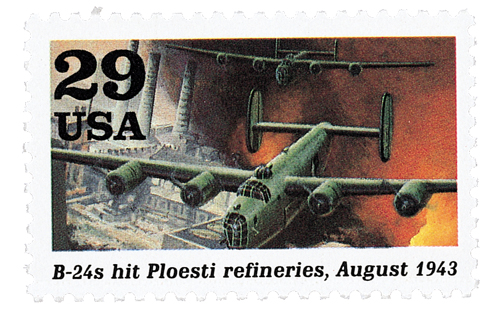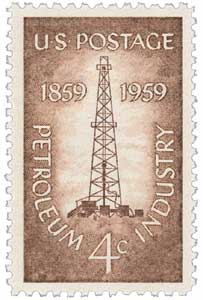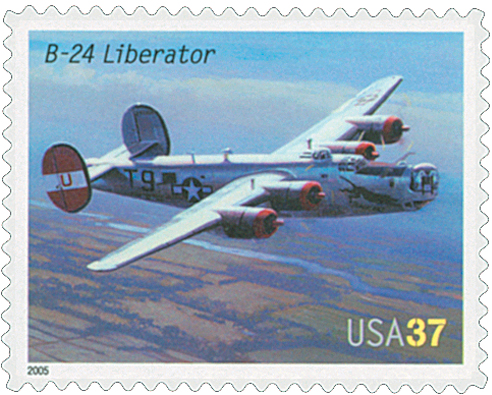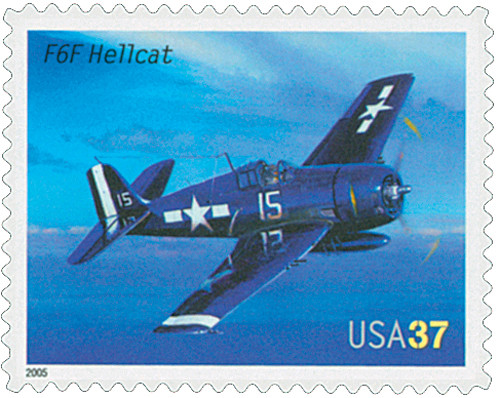
# 3922 - 2005 37c Advances in Aviation: Consolidated B-24 Liberator
37¢ B-24 Liberator
American Advances in Aviation
City: Oshkosh, WI
Printing Method: Lithographed
Color: Multicolored
Prior to U.S. entry into World War II, Consolidated Aircraft designed the B-24 Liberator. Because of its long range, the Liberator was able to perform missions over the Pacific Ocean and to patrol the North Atlantic Ocean where German submarines preyed on Allied ships.
Operation Tidal Wave

On August 1, 1943, US Army Air Forces bombed oil refineries in Ploesti, Romania. It was part of the Allies’ oil campaign, to cut off Germany’s petroleum supply during World War II.

Oil and the ability to move it to the places where it was most needed played a critical role in the success of both the Allied and Axis forces throughout World War II. A high priority for the Allies, the US kept streams of oil moving from the mid-west and southwest to loading terminals in the East. From there, the precious fluid was transported to the battlegrounds, where mobile pipelines followed the troops as they moved through Europe and North Africa.
The Axis however, depended upon reserves built up in peacetime and supplies seized in occupied countries. To win access to these great oil regions became a matter of life and death. When German U-boats began attacking tankers carrying oil from Venezuela and Texas, the Allies planned to retaliate by striking hard at the Axis’s main sources of oil.

In June 1942 a squad of 13 B-24 Liberators attacked Ploesti, Romania, which provided Germany and the Axis powers with about 30% of their oil. The attack inflicted minimal damage, but encouraged Germany and Romania to better defend the refineries. They set up anti-aircraft defenses, many hidden in haystacks, railroad cars, and fake buildings. They also had five squadrons totaling nearly 300 planes ready to defend Ploesti. These combined defenses made it one of the most heavily defended Axis targets in Europe.

The Allies planned another attack for August 1, 1943. The attack, dubbed Operation Tidal Wave, would target nine oil refineries around Ploesti. It was carried out by the Ninth and Eighth Air Force, totaling 1,751 aircrew flying 178 B-24 Liberators. It was one of the largest such operations up to that time.
Departing airfields in Benghazi, Libya early on the morning of August 1, 1943, the strike force had some issues during its flight to Romania. One plane crashed to the sea for unknown reasons, leading a few planes to go after it in search of survivors. Additionally, some planes came out of formation in heavy clouds and others followed the wrong rail line. They maintained radio silence as ordered for most of the flight, which further hindered their attack.

Once they reached their targets, the planes came under heavy fire from the Romanian anti-aircraft defenses. Some planes crash landed, killing the crews and civilians. Most of the planes that made it there managed to hit their targets, and when the operation was over it was estimated they had reduced Ploesti’s oil productivity by 40%. However Ploesti recovered quickly and even increased their output within weeks of the attack.

The mission was one of the most costly for the US Army Air Forces during the war. They lost 53 bombers and had 579 crewmen killed, wounded, or captured. Five Medals of Honor and 56 Distinguished Service Crosses were awarded to members of the mission. It was the most costly air raid of the war and became known as “Black Sunday.” A report years later called it “one of the bloodiest and most heroic missions of all time.”
37¢ B-24 Liberator
American Advances in Aviation
City: Oshkosh, WI
Printing Method: Lithographed
Color: Multicolored
Prior to U.S. entry into World War II, Consolidated Aircraft designed the B-24 Liberator. Because of its long range, the Liberator was able to perform missions over the Pacific Ocean and to patrol the North Atlantic Ocean where German submarines preyed on Allied ships.
Operation Tidal Wave

On August 1, 1943, US Army Air Forces bombed oil refineries in Ploesti, Romania. It was part of the Allies’ oil campaign, to cut off Germany’s petroleum supply during World War II.

Oil and the ability to move it to the places where it was most needed played a critical role in the success of both the Allied and Axis forces throughout World War II. A high priority for the Allies, the US kept streams of oil moving from the mid-west and southwest to loading terminals in the East. From there, the precious fluid was transported to the battlegrounds, where mobile pipelines followed the troops as they moved through Europe and North Africa.
The Axis however, depended upon reserves built up in peacetime and supplies seized in occupied countries. To win access to these great oil regions became a matter of life and death. When German U-boats began attacking tankers carrying oil from Venezuela and Texas, the Allies planned to retaliate by striking hard at the Axis’s main sources of oil.

In June 1942 a squad of 13 B-24 Liberators attacked Ploesti, Romania, which provided Germany and the Axis powers with about 30% of their oil. The attack inflicted minimal damage, but encouraged Germany and Romania to better defend the refineries. They set up anti-aircraft defenses, many hidden in haystacks, railroad cars, and fake buildings. They also had five squadrons totaling nearly 300 planes ready to defend Ploesti. These combined defenses made it one of the most heavily defended Axis targets in Europe.

The Allies planned another attack for August 1, 1943. The attack, dubbed Operation Tidal Wave, would target nine oil refineries around Ploesti. It was carried out by the Ninth and Eighth Air Force, totaling 1,751 aircrew flying 178 B-24 Liberators. It was one of the largest such operations up to that time.
Departing airfields in Benghazi, Libya early on the morning of August 1, 1943, the strike force had some issues during its flight to Romania. One plane crashed to the sea for unknown reasons, leading a few planes to go after it in search of survivors. Additionally, some planes came out of formation in heavy clouds and others followed the wrong rail line. They maintained radio silence as ordered for most of the flight, which further hindered their attack.

Once they reached their targets, the planes came under heavy fire from the Romanian anti-aircraft defenses. Some planes crash landed, killing the crews and civilians. Most of the planes that made it there managed to hit their targets, and when the operation was over it was estimated they had reduced Ploesti’s oil productivity by 40%. However Ploesti recovered quickly and even increased their output within weeks of the attack.

The mission was one of the most costly for the US Army Air Forces during the war. They lost 53 bombers and had 579 crewmen killed, wounded, or captured. Five Medals of Honor and 56 Distinguished Service Crosses were awarded to members of the mission. It was the most costly air raid of the war and became known as “Black Sunday.” A report years later called it “one of the bloodiest and most heroic missions of all time.”
















